Abstract
Pasteurella pestis, harvested after 24 to 30 hr of growth in a casein hydrolysate medium at 26 C, was resuspended and shaken in 3% lactose-0.1 m phosphate buffer for 4 hr at the same temperature. Certain characteristics of these starved cells were compared with those of control cells. No differences in the amounts of cellular carbohydrate or lipid were detected. The concentrations of the principal free amino acids were greater in the shaken cells, except that they contained no measureable arginine, and the normally large pools of intracellular tricarboxylic acid cycle intermediates were reduced. Greater viable-cell counts resulted with the cells that were shaken in lactose buffer than with the control cells when each was incubated at 5 C for several weeks. However, the reduced viabilities were apparent losses caused by the formation of aggregates of cells. The clumping of cells was caused by the polymerization of extracellular nucleic acids, principally deoxyribonucleic acid, that were excreted by the cells. Cell clumping could be partially prevented by prior shaking of the suspended cells, which removed some of the deleterious material, or by the action of crystalline deoxyribonuclease.
Full text
PDF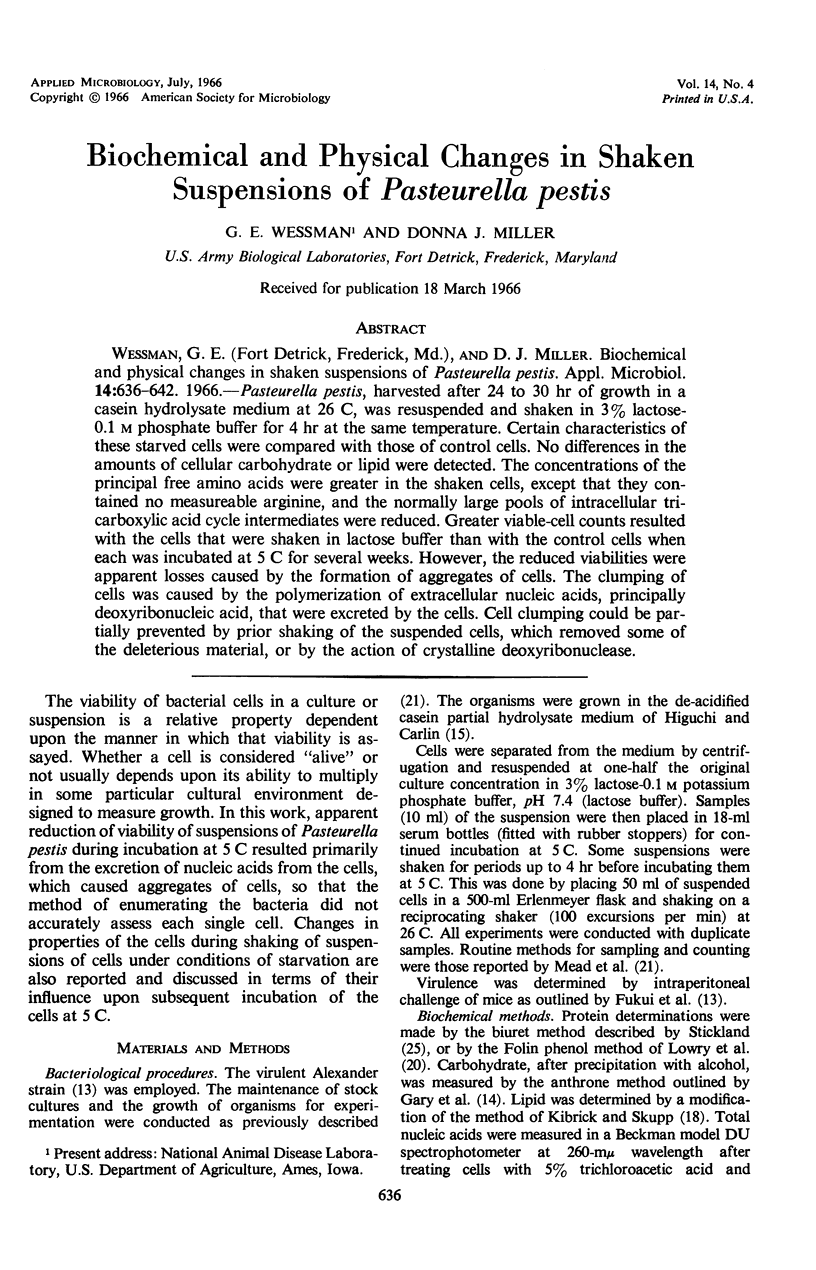
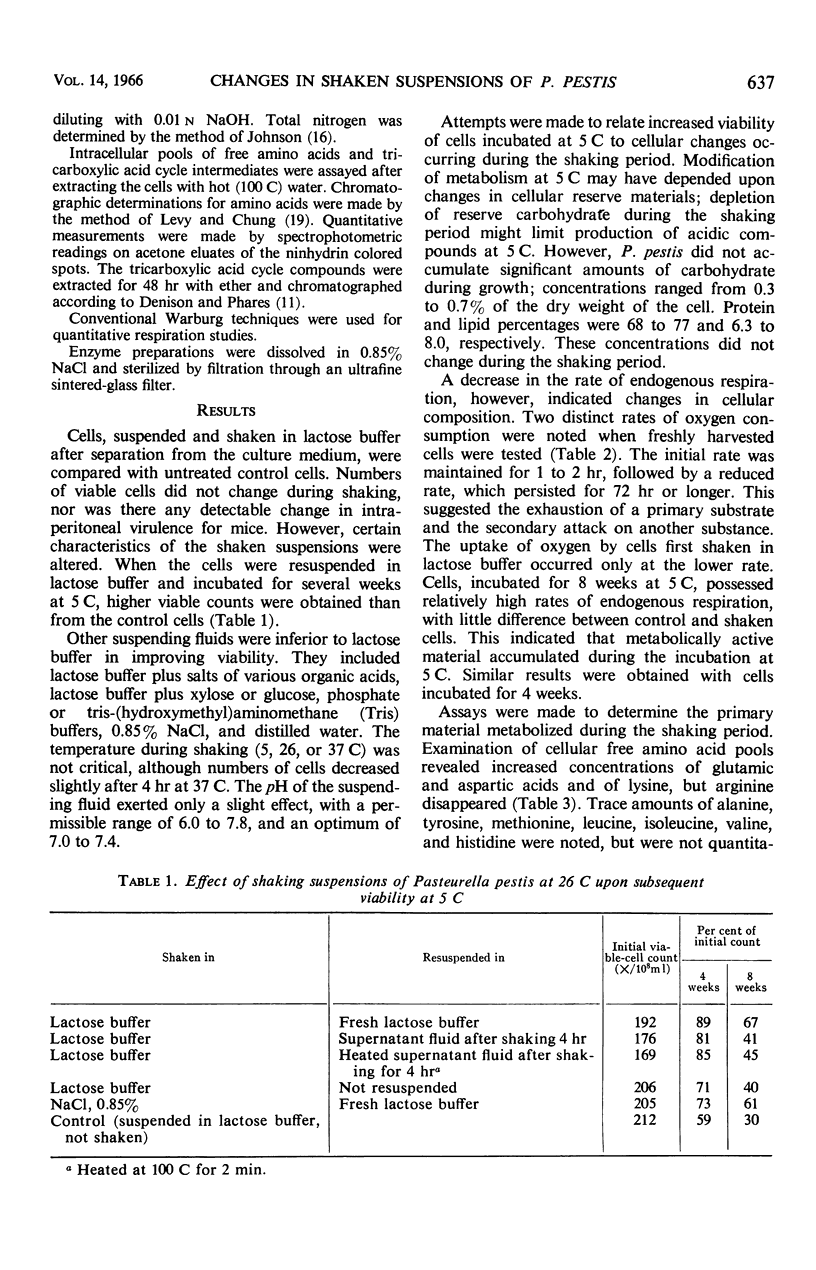
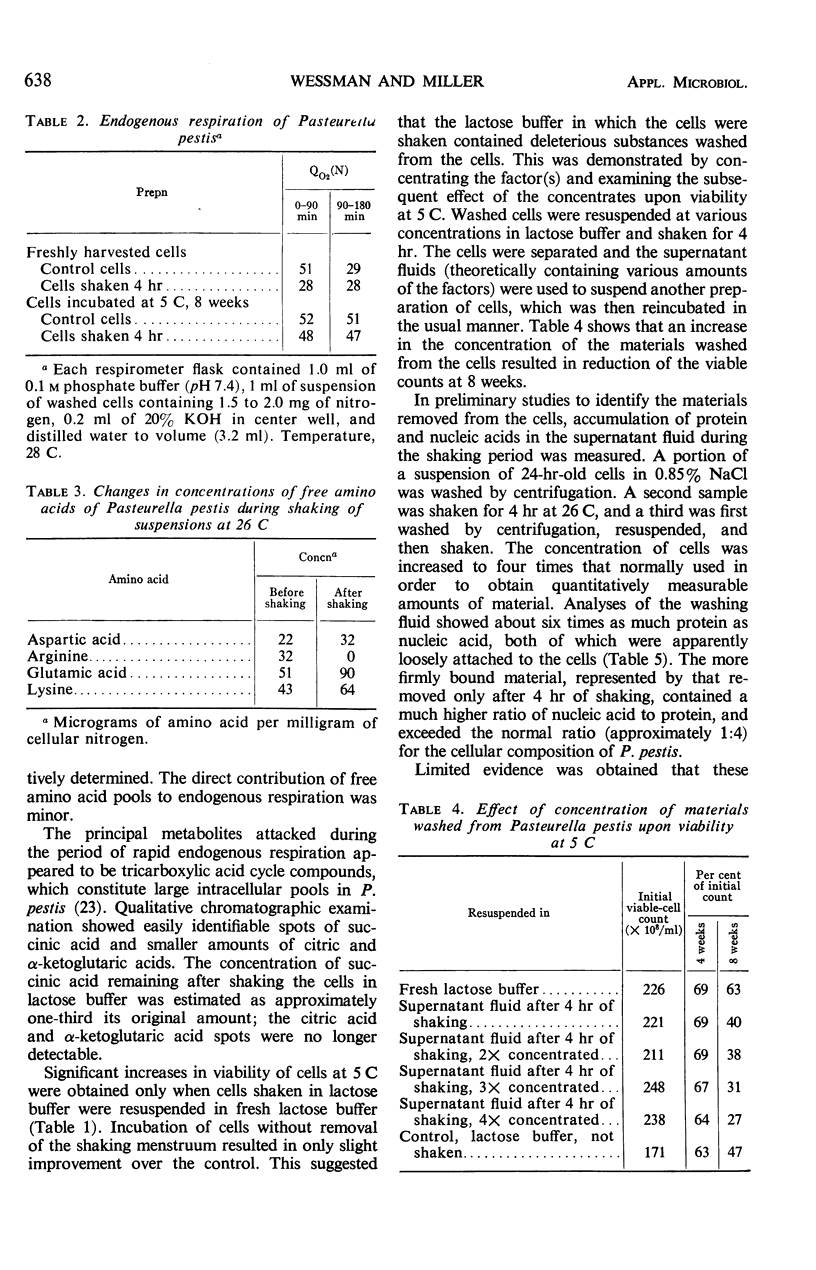
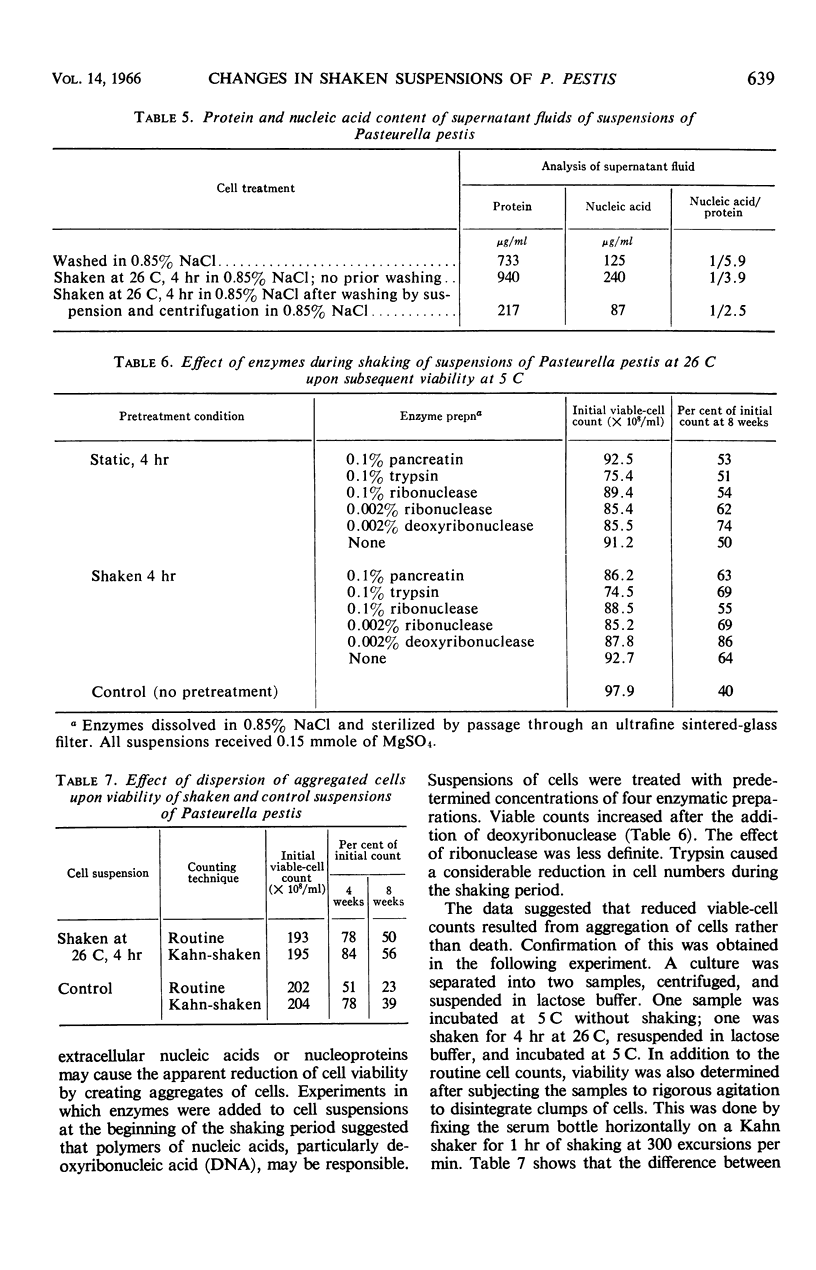
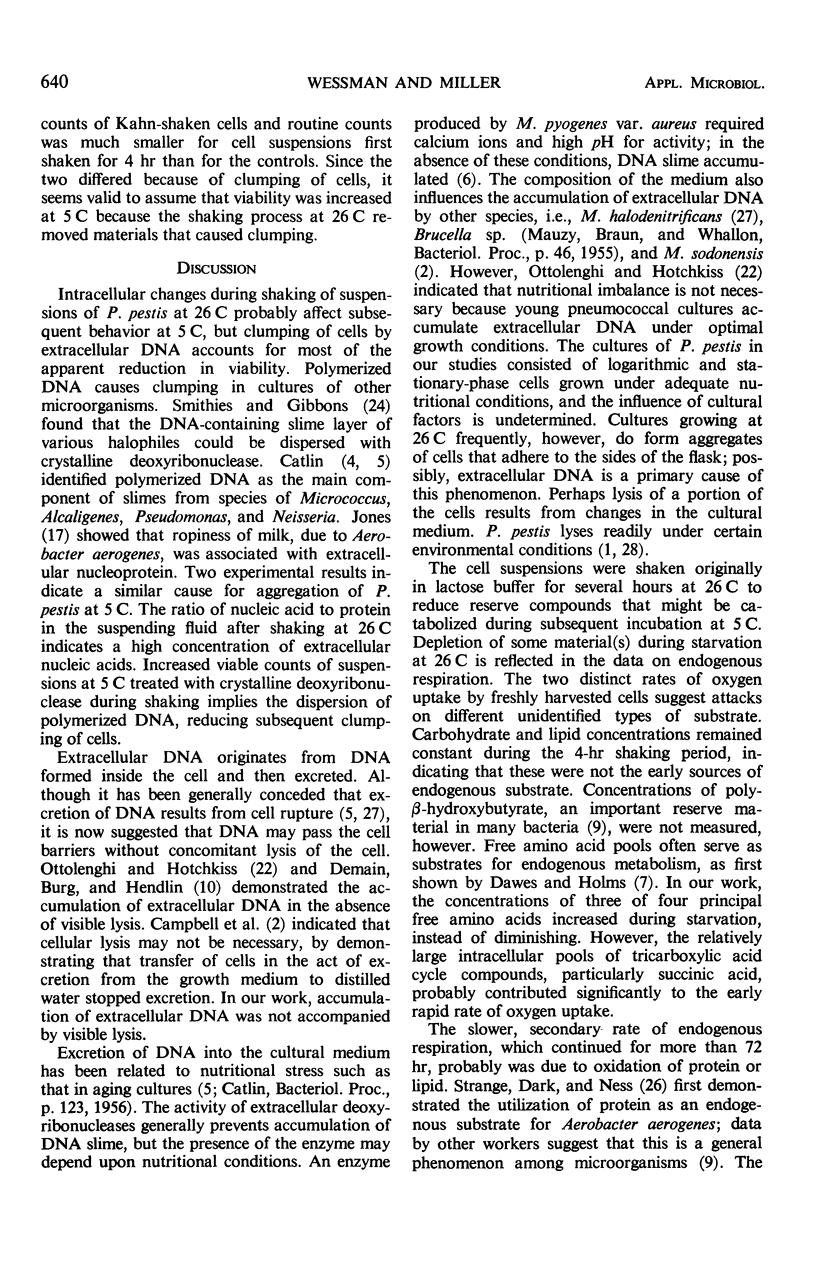
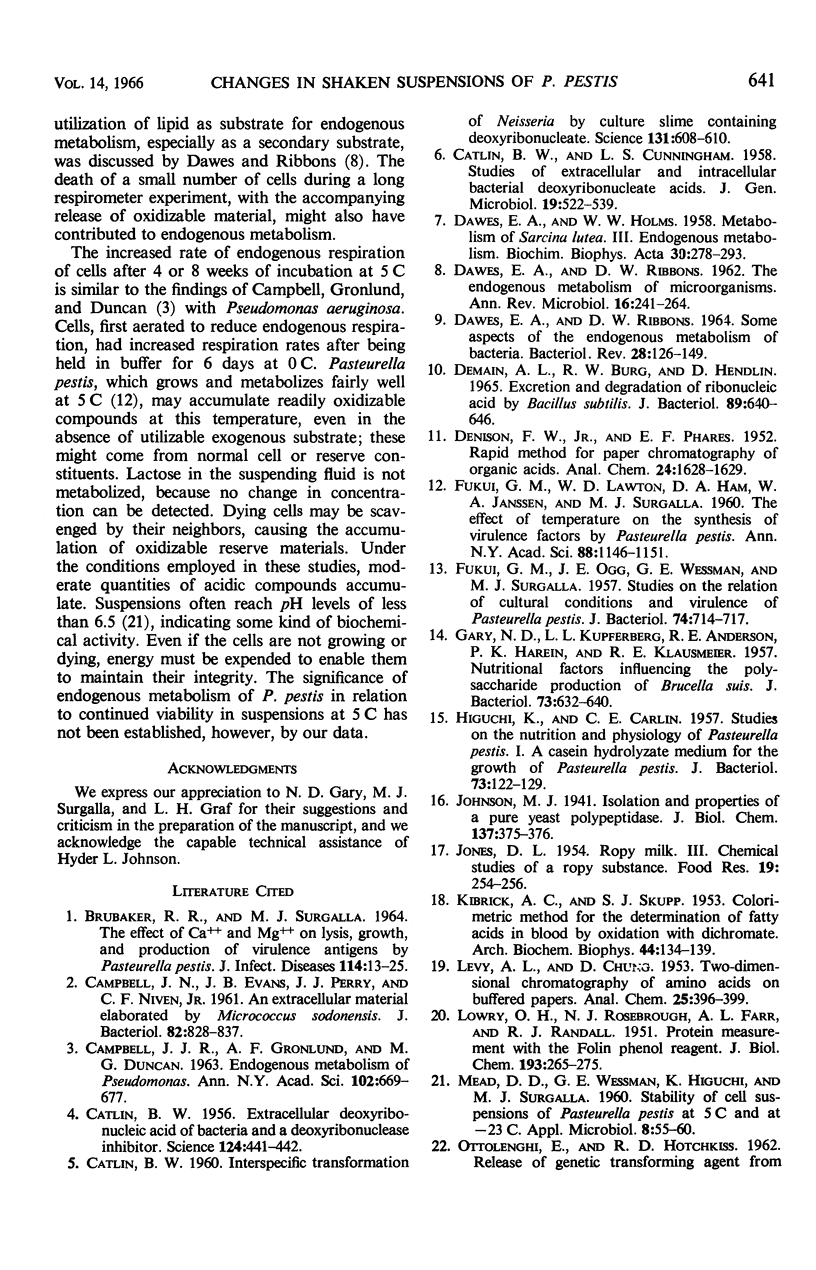
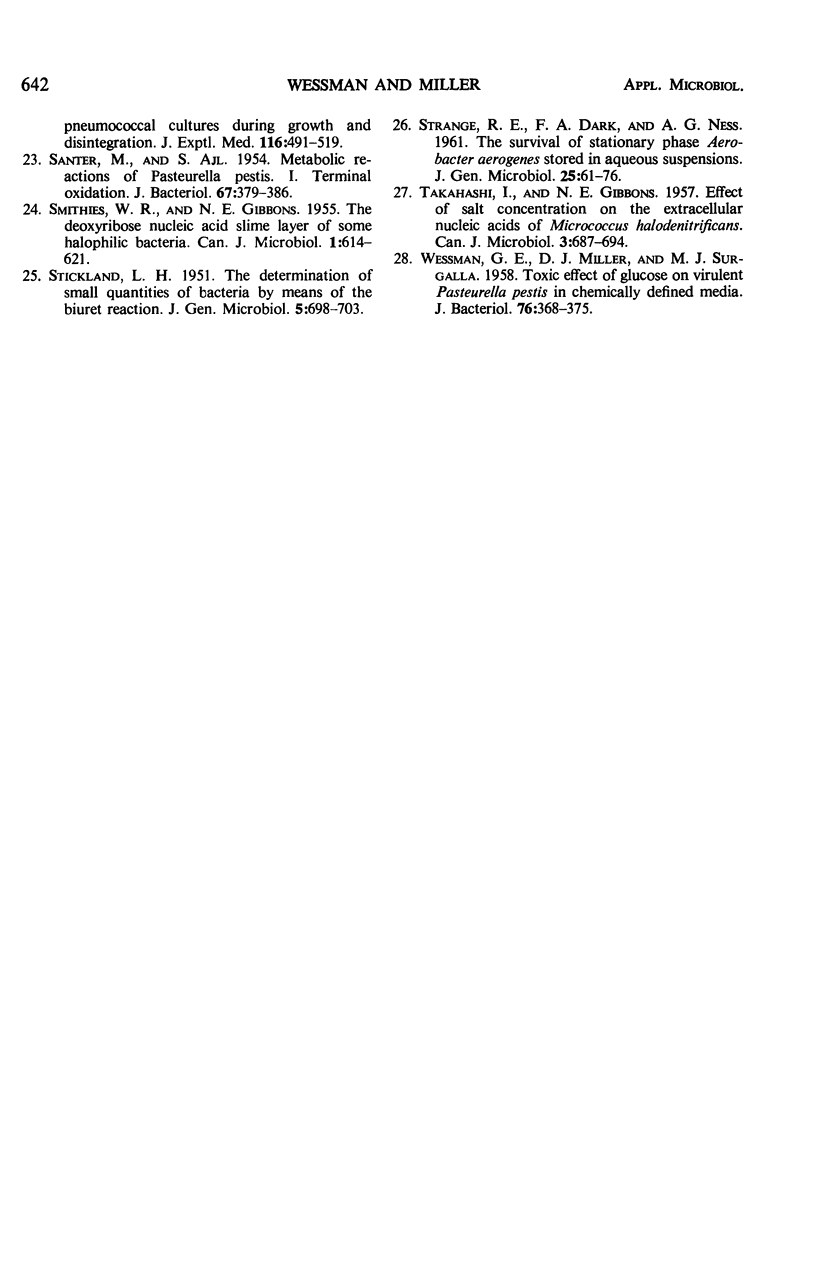
Selected References
These references are in PubMed. This may not be the complete list of references from this article.
- BRUBAKER R. R., SURGALLA M. J. THE EFFECT OF CA++ AND MG++ ON LYSIS, GROWTH, AND PRODUCTION OF VIRULENCE ANTIGENS BY PASTEURELLA PESTIS. J Infect Dis. 1964 Feb;114:13–25. doi: 10.1093/infdis/114.1.13. [DOI] [PubMed] [Google Scholar]
- CAMPBELL J. J., GRONLUND A. F., DUNCAN M. G. Endogenous metabolism of Pseudomonas. Ann N Y Acad Sci. 1963 Jan 21;102:669–677. doi: 10.1111/j.1749-6632.1963.tb13667.x. [DOI] [PubMed] [Google Scholar]
- CAMPBELL J. N., EVANS J. B., PERRY J. J., NIVEN C. F., Jr An extracellular material elaborated by Micrococcus sodonensis. J Bacteriol. 1961 Dec;82:828–837. doi: 10.1128/jb.82.6.828-837.1961. [DOI] [PMC free article] [PubMed] [Google Scholar]
- CATLIN B. W., CUNNINGHAM L. S. Studies of extracellular and intracellular bacterial deoxyribonucleic acids. J Gen Microbiol. 1958 Dec;19(3):522–539. doi: 10.1099/00221287-19-3-522. [DOI] [PubMed] [Google Scholar]
- CATLIN B. W. Extracellular deoxyribonucleic acid of bacteria and a deoxyribonuclease inhibitor. Science. 1956 Sep 7;124(3219):441–442. doi: 10.1126/science.124.3219.441. [DOI] [PubMed] [Google Scholar]
- CATLIN B. W. [Interspecific transformation of Neisseria by culture slime containing deoxyribonucleate]. Science. 1960 Feb 26;131(3400):608–610. doi: 10.1126/science.131.3400.608-a. [DOI] [PubMed] [Google Scholar]
- DAWES E. A., HOLMS W. H. Metabolism of Sarcina lutea. III. Endogenous metabolism. Biochim Biophys Acta. 1958 Nov;30(2):278–293. doi: 10.1016/0006-3002(58)90052-0. [DOI] [PubMed] [Google Scholar]
- DAWES E. A., RIBBONS D. W. SOME ASPECTS OF THE ENDOGENOUS METABOLISM OF BACTERIA. Bacteriol Rev. 1964 Jun;28:126–149. doi: 10.1128/br.28.2.126-149.1964. [DOI] [PMC free article] [PubMed] [Google Scholar]
- DAWES E. A., RIBBONS D. W. The endogenous metabolism of microorganisms. Annu Rev Microbiol. 1962;16:241–264. doi: 10.1146/annurev.mi.16.100162.001325. [DOI] [PubMed] [Google Scholar]
- DEMAIN A. L., BURG R. W., HENDLIN D. EXCRETION AND DEGRADATION OF RIBONUCLEIC ACID BY BACILLUS SUBTILIS. J Bacteriol. 1965 Mar;89:640–646. doi: 10.1128/jb.89.3.640-646.1965. [DOI] [PMC free article] [PubMed] [Google Scholar]
- FUKUI G. M., LAWTON W. D., HAM D. A., JANSSEN W. A., SURGALLA M. J. The effect of temperature on the synthesis of virulence factors by Pasteurella pestis. Ann N Y Acad Sci. 1960 Nov 21;88:1146–1151. doi: 10.1111/j.1749-6632.1960.tb20104.x. [DOI] [PubMed] [Google Scholar]
- FUKUI G. M., OGG J. E., WESSMAN G. E., SURGALLA M. J. Studies on the relation of cultural conditions and virulence of Pasteurella pestis. J Bacteriol. 1957 Dec;74(6):714–717. doi: 10.1128/jb.74.6.714-717.1957. [DOI] [PMC free article] [PubMed] [Google Scholar]
- GARY N. D., KUPFERBERG L. L., ANDERSON R. E., HAREIN P. K., KLAUSMEIER R. E. Nutritional factors influencing the polysaccharide production of Brucella suis. J Bacteriol. 1957 May;73(5):632–640. doi: 10.1128/jb.73.5.632-640.1957. [DOI] [PMC free article] [PubMed] [Google Scholar]
- HIGUCHI K., CARLIN C. E. Studies on the nutrition and physiology of Pasteurella pestis. I. A casein hydrolyzate medium for the growth of Pasteurella pestis. J Bacteriol. 1957 Jan;73(1):122–129. doi: 10.1128/jb.73.1.122-129.1957. [DOI] [PMC free article] [PubMed] [Google Scholar]
- KIBRICK A. C., SKUPP S. J. Colorimetric method for the determination of fatty acids in blood by oxidation with dichromate. Arch Biochem Biophys. 1953 May;44(1):134–139. doi: 10.1016/0003-9861(53)90016-2. [DOI] [PubMed] [Google Scholar]
- LOWRY O. H., ROSEBROUGH N. J., FARR A. L., RANDALL R. J. Protein measurement with the Folin phenol reagent. J Biol Chem. 1951 Nov;193(1):265–275. [PubMed] [Google Scholar]
- MEAD D. D., WESSMAN G. E., HIGUCHI K., SURGALLA M. J. Stability of cell suspensions of Pasteurella pestis at 5 C and at -23 C. Appl Microbiol. 1960 Jan;8:55–60. doi: 10.1128/am.8.1.55-60.1960. [DOI] [PMC free article] [PubMed] [Google Scholar]
- OTTOLENGHI E., HOTCHKISS R. D. Release of genetic transforming agent from pneumococcal cultures during growth and disintegration. J Exp Med. 1962 Oct 1;116:491–519. doi: 10.1084/jem.116.4.491. [DOI] [PMC free article] [PubMed] [Google Scholar]
- SANTER M., AJL S. Metabolic reactions of pasteurella pestis. I. Terminal oxidation. J Bacteriol. 1954 Apr;67(4):379–386. doi: 10.1128/jb.67.4.379-386.1954. [DOI] [PMC free article] [PubMed] [Google Scholar]
- SMITHIES W. R., GIBBONS N. E. The deoxyribose nucleic acid slime layer of some halophilic bacteria. Can J Microbiol. 1955 Oct;1(8):614–621. doi: 10.1139/m55-074. [DOI] [PubMed] [Google Scholar]
- STICKLAND L. H. The determination of small quantities of bacteria by means of the biuret reaction. J Gen Microbiol. 1951 Oct;5(4):698–703. doi: 10.1099/00221287-5-4-698. [DOI] [PubMed] [Google Scholar]
- TAKAHASHI I., GIBBONS N. E. Effect of salt concentration on the extracellular nucleic acids of Micrococcus halodenitrificans. Can J Microbiol. 1957 Aug;3(5):687–694. doi: 10.1139/m57-076. [DOI] [PubMed] [Google Scholar]
- WESSMAN G. E., MILLER D. J., SURGALLA M. J. Toxic effect of glucose on virulent Pasteurella pestis in chemically defined media. J Bacteriol. 1958 Oct;76(4):368–375. doi: 10.1128/jb.76.4.368-375.1958. [DOI] [PMC free article] [PubMed] [Google Scholar]


